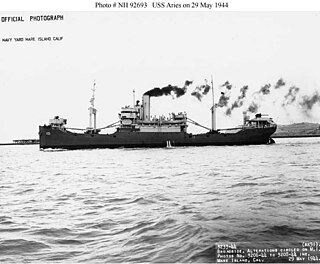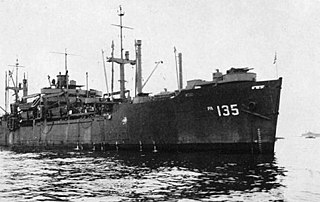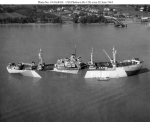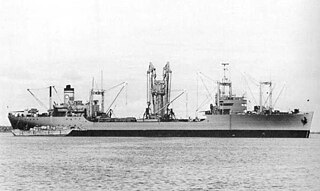
USS Aries (AK-51) (1918–1952) was a United States Navy cargo ship built as Lake Geneva under a United States Shipping Board (USSB) contract in 1918 at Duluth, Minnesota, by the McDougall Duluth Shipbuilding Company, to augment American logistics capability during World War I. The freighter was delivered to the Navy at Montreal, Quebec, Canada, on 21 September 1918 and was placed in commission the following day for service in the Naval Overseas Transportation Service. Aries was named for the constellation.

The USS Albireo (AK-90) was a Crater-class cargo ship in the service of the US Navy in World War II and manned by a US Coast Guard crew. She was the only ship of the Navy to have borne this name. She is named after Albireo, a star in the constellation of Cygnus.

SS Mission San Juan was a Type T2-SE-A2 tanker built for the United States Maritime Commission during World War II. After the war she was acquired by the United States Navy as USS Mission San Juan. Later the tanker transferred to the Military Sea Transportation Service as USNS Mission San Juan. She was a member of the Mission Buenaventura-class oiler and was named for Mission San Juan Bautista in San Juan Bautista, California.

USNS Redstone, designated T‑AGM‑20, was a tracking ship assigned to Apollo space mission support under the control of the Eastern Range. For a brief time during conversion the ship was named Johnstown with the designation AGM‑20.
USS Beagle (IX-112), was an Armadillo class tanker designated an unclassified miscellaneous vessel. She was the second ship of the United States Navy to be named for the beagle, a breed of small, short-coated hunting hound.
USS Elk (IX-115), an Armadillo-class tanker designated an unclassified miscellaneous vessel, was the second ship of the United States Navy to be named for the elk, a large deer of the northern forests of Europe, Asia, and North America. Her keel was laid down by California Shipbuilding Corporation, in Wilmington, Los Angeles, as William Winter for the Maritime Commission. She was launched on 6 November 1943 sponsored by Mrs. H. H. Hall, delivered direct to the Navy 26 November 1943, and commissioned the same day.
USS Armadillo (IX-111), the lead ship of her class of tanker was the only ship of the United States Navy to be named for the armadillo, an insect-eating mammal which has an armorlike shell encasing its back and head.

USS Bosque (APA-135) was a Haskell-class attack transport in service with the United States Navy from 1944 to 1946. She was scrapped in 1973.

USS Doyen (APA-1) was a Doyen-class attack transport in service with the United States Navy from 1943 to 1946. She was scrapped in 1973.

USS Uranus (AF-14) was a Uranus-class stores ship bareboat chartered to the U.S. Navy by the War Shipping Administration for use in World War II. The ship was one of the Danish vessels idled in U.S. ports seized by the United States after the occupation of Denmark by German forces. The ship was the Danish J. Lauritzen A/S line vessel Maria, ex Caravelle, ex Helga until chartered to the Navy and commissioned on 11 August 1941 under the name Uranus.

USS Mintaka (AK-94) was a Crater-class cargo ship commissioned by the US Navy for service in World War II. She was named after Mintaka, a star in the Orion constellation. Mintaka was crewed by United States Coast Guard personnel and was responsible for delivering troops, goods and equipment to locations in the Asiatic-Pacific Theater.

USS Allioth (AK-109/IX-204/AVS-4) was a Crater-class cargo ship commissioned by the US Navy for service in World War II, named after Alioth, a star in constellation Ursa Major. She was responsible for delivering troops, goods and equipment to locations in the war zone.

USS Alkes (AK-110) was a Crater-class cargo ship commissioned by the US Navy for service in World War II, named after Alkes, a star in the Crater constellation. She was responsible for delivering troops, goods and equipment to locations in the war zone.

USS Phobos (AK-129) was a Crater-class cargo ship commissioned by the U.S. Navy for service in World War II. She was responsible for delivering troops, goods and equipment to locations in the war zone.
USS Mastic (AN-46/YN-65) was an Ailanthus-class net laying ship which served with the U.S. Navy in the South Pacific Ocean theatre of operations during World War II. Her career was without major incident, and she returned home safely after the war.
USS Bitterbush (AN-39/YN-58) was an Ailanthus-class net laying ship which served with the U.S. Navy in the western Pacific Ocean theatre of operations during World War II. She served the U.S. Pacific Fleet with her protective anti-submarine nets, and returned home safely after the war with one battle star to her credit.
USNS Sgt. Truman Kimbro (T-AK-254) was a Boulder Victory-class cargo ship built for the U.S. Maritime Commission during the final months of World War II as the SS Hastings Victory.
HMS Sansovino was an infantry landing ship in service with the Royal Navy during the late stages of the Second World War.

USNS Private Leonard C. Brostrom (T-AK–255) was a cargo ship for the United States Navy that was converted into a heavy lift cargo ship in the early 1950s. She was built in 1943 for the United States Maritime Commission as SS Marine Eagle, a Type C4-S-B1 tank carrier, by Sun Shipbuilding during World War II. In 1948, she was transferred to the United States Army as USAT Private Leonard C. Brostrom after Leonard C. Brostrom, a recipient of the Medal of Honor. In 1950, the ship was transferred to the Military Sea Transport Service of the U.S. Navy as a United States Naval Ship staffed by a civilian crew. After ending her naval service, she entered the National Defense Reserve Fleet in October 1980 and was sold for scrapping in June 1982.
T. J. Stevenson & Company, Inc. was a shipping firm founded in New York City by Thomas J. Stevenson on December 2, 1935. In 1920 Thomas J. Stevenson started working as a ship broker in New York City. Thomas J. Stevenson's father Henery Stevenson worked as a clerk at a shipping firm in New York City starting in 1910. T. J. Stevenson & Company supported the World War II effort by operating United States owned ships. After the war T. J. Stevenson & Company purchased surplus war cargo ships. Thomas J. Stevenson was born in 1892 and died on January 28, 1968.











